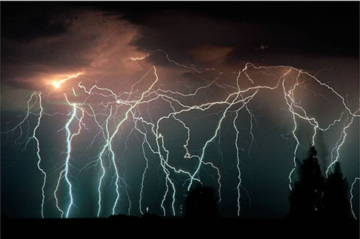Sean J Patrick Carney at Art In America:
 It’s more colorful on the high desert plains of western New Mexico’s remote Catron County than most Americans probably think: a rainbow of gold, sanguine, and umber, blotted with shocks of assertive teals and jades, and accents of muted violet. A dozen miles east of the Continental Divide, at an elevation of 7,200 feet, the sky is inescapable, glowing so blue that it borders on the psychedelic. Here, in 1977, Walter De Maria, along with a small army of surveyors, engineers, contractors, patrons, and local high school students, installed the artist’s best-known work, The Lightning Field. Four hundred stainless steel poles, one placed every 220 feet, mark a precise rectangular grid that measures one mile by one kilometer. Each pole is machined to two inches in diameter, though, to account for the uneven terrain, their heights vary—between 15 feet and close to 27 feet—such that their tips reach an effectively level plane.
It’s more colorful on the high desert plains of western New Mexico’s remote Catron County than most Americans probably think: a rainbow of gold, sanguine, and umber, blotted with shocks of assertive teals and jades, and accents of muted violet. A dozen miles east of the Continental Divide, at an elevation of 7,200 feet, the sky is inescapable, glowing so blue that it borders on the psychedelic. Here, in 1977, Walter De Maria, along with a small army of surveyors, engineers, contractors, patrons, and local high school students, installed the artist’s best-known work, The Lightning Field. Four hundred stainless steel poles, one placed every 220 feet, mark a precise rectangular grid that measures one mile by one kilometer. Each pole is machined to two inches in diameter, though, to account for the uneven terrain, their heights vary—between 15 feet and close to 27 feet—such that their tips reach an effectively level plane.
As the sun rises and relaxes from its midday meridian, the poles reflect the surrounding earth and sky, creating the illusion that they have disappeared.
more here.
